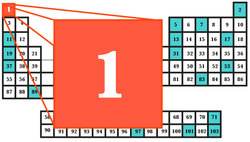Integer chemistry II
 Integers, like molecules, are built from atoms. However there's only one element in the periodic table of maths, namely the number 1, and all other integers can be built from it. For example, there are several ways to build the number 6:
Integers, like molecules, are built from atoms. However there's only one element in the periodic table of maths, namely the number 1, and all other integers can be built from it. For example, there are several ways to build the number 6:
6 = 1 + 1 + 1 + 1 + 1 + 1 = ( 1 + 1 ) ∗ ( 1 + 1 ) + 1 + 1 = ( 1 + 1 ) ∗ ( 1 + 1 + 1 )
We say the number 6 has complexity 5, because that's the cheapest (using the fewest ones) way it can be built. The allowed operations are addition, multiplication and brackets. It's not allowed to write two ones next to each other to make 11.
What's the complexity of the number 31?
The answer is 11.
This section requires Javascript.
You are seeing this because something didn't load right. We suggest you, (a) try
refreshing the page, (b) enabling javascript if it is disabled on your browser and,
finally, (c)
loading the
non-javascript version of this page
. We're sorry about the hassle.
6 solutions
( 1 + 1 ) ∗ ( 1 + 1 + 1 ) ∗ ( 1 + 1 + 1 + 1 + 1 ) + 1 = 2 ∗ 3 ∗ 5 + 1 = 3 0 + 1 = 3 1
In total, 2 1's * 3 1's * 5 1's + 1 = 31, means 11 1's were used. 1 1
31 = (10 * 3) + 1
The complexity of 10 is 7
The complexity of 3 is 3
The complexity of 1 is 1
So, we have 7 + 3 + 1 = 11
By the rules below it is how i solved
(1+1+1+1+1)x(1+1+1)x(1+1)+1=31
(5)x(3)x(2)+1=31
sum those number and complexity of the number 31 is..
(5)+(3)+(2)+1=11
it is 11 by this method 31=(1+1) (1+1+1) (1+1+1+1+1)+1 so total no. of "1" is 11 thus, it;s complexity is 11
I got 11 by (1+1) *(1+1) *(1+1) *(1+1) *(1+1) -1 = 31
(1+1+1) * (1+1+1+1+1) * (1+1) +1
Since 31 is a prime number, we can only optimize the complexity of 31 by optimizing the nearest non-prime number i.e 30, whose prime factorization is 2 ∗ 3 ∗ 5 .
Each of these individual blocks can be represented only by 1s added to themselves, giving 30 a complexity of 10.
Ultimately, 31 ends up having (complexity (30))+1 = 1 1